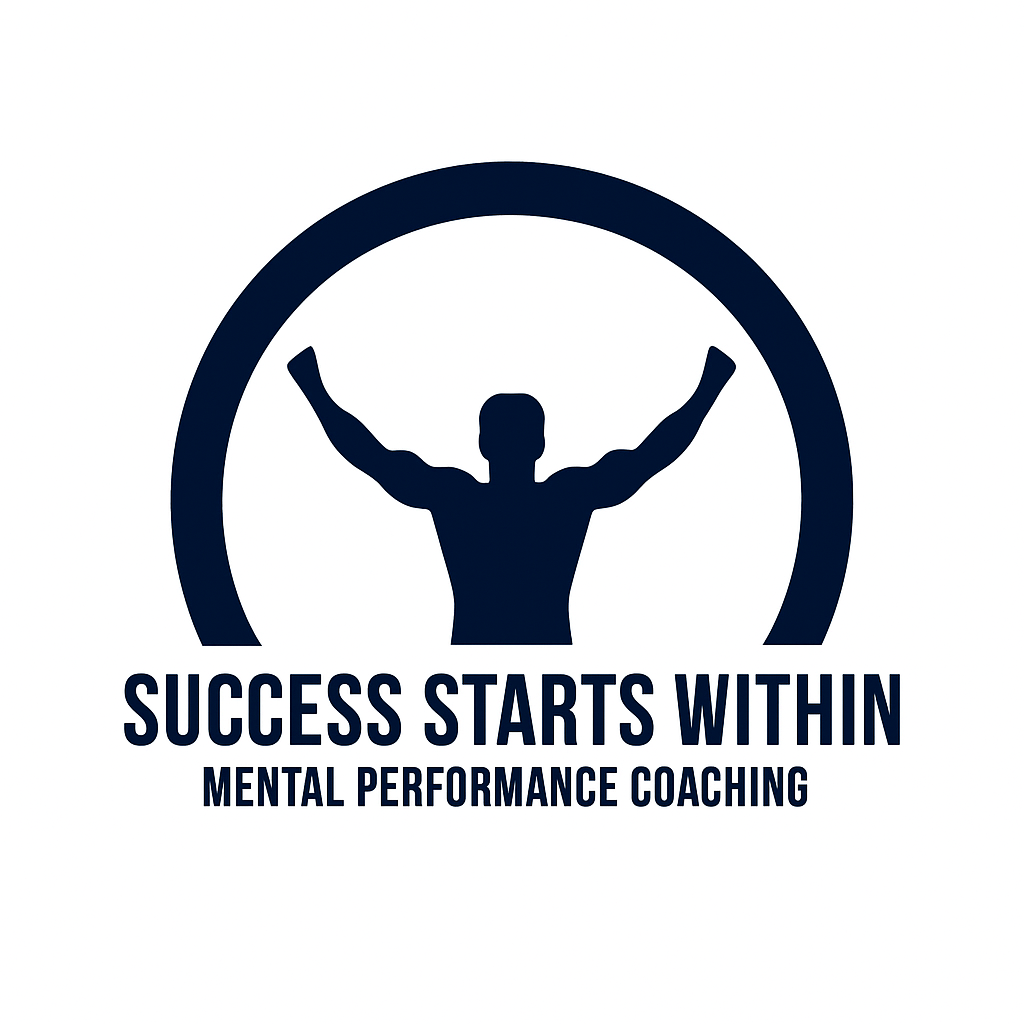As a mental performance coach one of the main concepts I focus on with athletes is sports visualization.
Venture into the realm of sport psychology and it won’t be long before you come across the term visualization.
I find there to be two general reactions from people when they’re introduced to visualization in sports. Either they’re interested and grow excited by the prospect of utilizing their minds for success, or they become sceptical of what seems to be an out there technique.
Having fallen into both categories at one time or another, I understand the reasoning behind each point of view. However, as time has gone on, and my experience with sports visualization has grown, there’s been one view point I’ve latched onto and don’t plan on changing.
I firmly hold to the belief that visualization is a powerful tool for athletes and performers to use.
In this article we are going to focus on athletics. By highlighting the benefits of visualization in sports and revealing four sports visualization techniques for athletes, you can begin implementing this valuable tool into your training regimen.
Visualization Defined
One word comes to mind when seeking to define sports visualization: imagination.
Do you remember as a kid, creating a whole world within your mind? You’d be playing around with your friends or siblings, in what appeared to be the living room of your home.
But in your head, you were actually venturing through the fields of a fantasy land, seeking a buried treasure or going to fight an evil dragon.
So, what does the imagination play you did as a child have to do with athletic performance? Well, it goes to show how powerful your imagination is. I want you to remember just how real those imaginary worlds used to feel.
On betterhelp.com visualization is defined as the formation of mental visual images.
I like that definition, but I want to take it one step further, by adding the word scenes. For me, sports visualization is all about creating mental scenes.
When you were a kid, you constructed whole worlds within your mind. These scenes played out in such a real way, you could entertain yourself with them for hours on end.
There is no difference in the mental processes between children using their imaginations for enjoyment and you utilizing visualization in sports to improve your athletic performance.
In both situations, a scene is created in your mind, directed by you to play out in the manner you decide.
“There is no difference in the mental processes between children using their imaginations for enjoyment and you utilizing visualization to improve your athletic performance. In both situations, a scene is created in your mind, directed by you to play out in the manner you decide.”
Science Behind Sports Visualization
Alright, time to get technical. Why does this stuff work in the first place? Is there any scientific backing for the implementation of visualization in an athlete’s routine?
The answer is emphatically, yes. It has to do with the neural circuits found within the brain. A research paper released by the International Coach Academy goes into detail on how our brains are creating new connections between neurons with each skill we learn.
As you learn something, such as throwing a baseball or shooting a basketball, the brain is developing memory of the act. Memory is the new neural connections created, so as you seek to perform the act again, your mind simply knows what to do.
Now, it’s not a one time event that creates such memory, but repetitive action. It’s not just physical repetition that strengthens these new connections, either.
Imagery work, also known as visualization, has the same effect on the brain. Here is a direct quote from the research paper explaining how this process works:
“If you exercise an idea over and over, your brain will begin to respond as though the idea was a real object in the world. The thalamus makes no distinction between inner and outer realities, and thus any idea, if contemplated long enough, will take on a semblance of reality. Your belief becomes neurologically real and your brain will respond accordingly.”
I love that term, neurologically real. Our minds perceive the visualization as a real life event. That is why mental imagery work proves beneficial to athletes.
No matter the technique you choose out of the ones discussed below, the reason for its effectiveness lies in this scientific finding.
Benefits of Visualization on Athletic Performance
Now that you know what sports visualization is and why it works, let’s examine some of the main areas visualization can benefit athletes. These will directly correlate with the techniques I will introduce in the next section.
When it comes to visualization in sports, the aim should be to improve your performance. In order to do so, we must examine the mental game challenges that derail athletes from performing their best.
Some of these will include:
- Low Confidence
- Sports Performance Anxiety
- Fear of Failure
- Perfectionism
- High Stress
- Inability to Handle Pressure
- Lack of Motivation
- Injury
So, in terms of the benefits derived from visualization in sports, they will need to be an inverse reflection of the mental game challenges you see above. Let’s take a look at a few of the main areas visualization improves performance:
Visualization Reduces Stress & Anxiety
I had a coach that would always say, “A relaxed hitter is a dangerous hitter.”
He meant that, the more relaxed a player was in the batter’s box, the more likely he was to get a hit. Do you know why? Because in order to be relaxed in that sort of situation, your mind must be calm.
Having a calm mind means it’s free from distracting thoughts. On the other hand, a tense hitter, one whose mind is full of stress and anxiety, is a much easier out for a pitcher and will never perform up to their full athletic potential.
This holds true for all athletes, not just hitters. Performing relaxed is so important, yet unattainable if stress or anxiety is your natural state. Visualization provides you with a way to reduce the amounts of stress and anxiety you feel.
By getting your mind into a relaxed state, as you’ll learn later in the article, you can generate a feeling of calm that will make you a deadly competitor, no matter the sport you play.
“Performing relaxed is so important, yet unattainable if stress or anxiety is your natural state. Visualization provides you with a way to reduce the amounts of stress and anxiety you feel.”
Visualization Helps You Manage Pressure
One of the most sought after titles in sports is that of a clutch player. The athlete who coaches, teammates, and fans trust in pressure moments, and the one opponents fear.
How do you gain such a title? By developing the ability to manage yourself under pressure. Feelings of pressure are derived from outcome-oriented thinking. If you are focused on the outcome, it’s easy to have self-doubt creep into your mind.
So, to better handle these pressure filled moments, you must go into them with the utmost confidence.
Visualization in sports proves to be valuable in building high levels of self-confidence. Through the process of imagining yourself succeeding under pressure, confidence will grow. The next time you find yourself in such a situation, you’ll know you have the confidence to succeed.
Visualization Helps During Injury Recovery
Finding yourself sidelined due to injury is incredibly frustrating. Being forced to watch your teammates compete, knowing you can do nothing to help, takes a negative toll on the mind.
It can also be difficult to deal with the fact you are not training to improve your skills. When injured, there is little chance you’ll be able to keep practicing, otherwise, you’d be able to play.
When you are unable to practice, a feeling grows that you are falling behind the competition. So, there needs to be an alternative by which you can still work on progressing your skills while sidelined due to injury.
Visualization is such a tool. While you may not be physically capable of training, your mind is readily available to step in and take over the workload.
Utilizing sports visualization while injured allows you to work on skill mastery, building confidence, reducing anxiety, and many other mental characteristics. If used diligently, visualization can help you return from injury having actually gained a leg up on the competition.
4 Visualization Techniques For Athletes
As you can tell from the benefits listed above, visualization is an incredible tool for athletes and performers. No other mental training tool provides you with the ability to influence your brain in the same way as a real life event.
Through the power of visualization in sports, you can build new neural connections that will increase memory within your mind.
As with any tool, however, starting out can be daunting if you don’t have a process in place. You may want to visualize for confidence, or to help with injury, but you don’t know how to get started.
That’s why a solid technique to follow is valuable. The rest of this article covers four techniques you can use to handle pressure, gain mastery in a skill, relax, and train while injured.
Visualization Technique #1: Handling Pressure
Feeling pressure as an athlete can be the motivating push you need to perform your best. However, for many of us, such high stress moments have the opposite effect, leading to lower levels of performance.
When you find yourself in a pressure filled situation, what can you do to calm yourself, recentering your mind on the process that will help you succeed? It comes down to your emotional state.
You must learn how to alter the state you are in, shifting from high stress and tense, to calm, relaxed, and confident. This can be trained through visualization. The technique looks like this:
- Step 1: Find yourself a quiet location, free from any distractions.
- Step 2: Get into a comfortable position with your back straight. Either sitting on a chair or on the ground. Avoid lying on a couch, as that will make it more difficult to visualize clearly.
- Step 3: Breathe to get yourself relaxed. Take ten to twenty deep breaths, focusing on your breath and allowing your mind to become settled.
- Step 4: Create your image. Now you want to bring yourself into the moment in which you feel pressure. Make it as real as possible by incorporating all the sights and sounds of the environment.
- Step 5: Generate your optimal emotional state. If you make the situation real enough, your normal emotions will set in. Recognize them, and then replace them with how you wish to feel. Feel relaxed, calm, and confident, see yourself succeeding.
Through this technique, you are training yourself to alter your emotional state under pressure. The more you train this, the better you will be at handling pressure.
“Feeling pressure as an athlete can be the motivating push you need to perform your best. However, for many of us, such high stress moments have the opposite effect, leading to lower levels of performance.”
Visualization Technique #2: Relaxation
Whether it’s to handle pressure, cope with sports performance anxiety, or any other challenge that gets in the way of performing up to your peak, being able to get into a relaxed state is vital to your success as a performer.
A lot of times we think the more excited and amped up we get, the better we play. However, that’s not always the case. Especially when you have the tendency to grow anxious or fearful during a game, relaxation is your best friend.
Relaxation is a skill, one you can develop through practice. Here is what a visualization routine for relaxation looks like:
- Step 1: Find yourself a quiet location, free from any distractions.
- Step 2: Get into a comfortable position with your back. Either sitting on a chair or on the ground. Avoid lying on a couch, as that will make it more difficult to visualize clearly.
- Step 3: Breathe to get yourself relaxed. Take ten to twenty deep breaths, focusing on your breath and allowing your mind to become settled.
- Step 4: Imagine a situation in which you feel the most relaxed and at peace. The scene does not matter as much as the emotions it generates. For me, I like to visualize myself on the beach. Either sitting there, looking out at the ocean or walking along with my dog. Be sure to be vivid within your imagery and make sure the emotions are intense enough to be called upon in the future.
Now before a game, during a game, or any time you find yourself feeling stressed, bring the scene you just created back into your mind. The more you practice, the better you will become at immediately generating feelings of relaxation.
“A lot of times we think the more excited and amped up we get, the better we play. However, that’s not always the case. Especially when you have the tendency to grow anxious or fearful during a game, relaxation is your best friend.”
Visualization Technique #3: Skill Mastery
For this technique, we are greatly playing into the idea of building new neural connections within your brain. Just as with physical training, you can learn to master a skill through mental exercises.
This isn’t meant to be a substitute to physical training, but an addition, providing you with another facet of training to elevate your skill level.
Here is how to use visualization for skill mastery:
- Step 1: Find yourself a quiet location, free from any distractions.
- Step 2: Get into a comfortable position with your back. Either sitting on a chair or on the ground. Avoid lying on a couch, as that will make it more difficult to visualize clearly.
- Step 3: Breathe to get yourself relaxed. Take ten to twenty deep breaths, focusing on your breath and allowing your mind to become settled.
- Step 4: Begin to create your scene. I’ll use a baseball player hitting as an example. You can visualize yourself hitting off a tee, then progress to hitting batting practice. From there, see yourself hitting in a game. The key is to make it detailed and real. See and feel yourself succeed each time.
This technique can be used for any skill you’d like. Use it before training, or even during training. It’s an incredible way to get extra practice in, without having to further tire yourself out physically.
Visualization Technique #4: Injury Recovery
When you’re sidelined, your confidence can take a hit, since you’re unable to train. Though, this no longer has to be the case. Through visualization, you can continue your training efforts, all while being injured.
Along with training your skills, you can strengthen the confidence you have in your body. One of the most difficult aspects of returning from an injury is trusting that your body is strong and one-hundred percent.
You can utilize visualization to see yourself once again performing in full health. Here is what both techniques will look like, with the first steps being the same for both:
- Step 1: Find yourself a quiet location, free from any distractions.
- Step 2: Get into a comfortable position with your back. Either sitting on a chair or on the ground. Avoid lying on a couch, as that will make it more difficult to visualize clearly.
- Step 3: Breathe to get yourself relaxed. Take ten to twenty deep breaths, focusing on your breath and allowing your mind to become settled.
- Step 4a: Create the scene of you performing. You can use the same technique as with skill mastery, going into detail, seeing yourself train. You can also visualize a whole game, or the parts of a game you’re involved in. That way, you are simulating game-like situations within your mind.
- Step 4b: Visualize yourself healed. See yourself free from injury, performing at full capacity. Feel gratitude and happiness for being able to return to the game you love.
Both of these are great ways to turn an ordinarily frustrating situation into an opportunity for growth within your sport.
Final Thoughts
Sports visualization is an incredible tool for athletes. The neural connections generated as you imagine yourself performing instill memory within your mind.
There are many ways you can go about utilizing visualization for athletic benefit. But, the four main areas I find most useful include visualization for handling pressure, relaxation, skill mastery, and injury recovery.
The first three steps will always be the same, working to get your mind and body in an optimal state to visualize. From there, the difference will be what you imagine and how it makes you feel.
Always remember to bring emotion into each scene!
I hope you enjoyed this article, and if you did, please share it with your friends.
If you are interested in getting a more tailored approach to visualization in sports, specific to your needs, learn how mental performance coaching can help. Thank you for reading and I wish you the best of success in all that you do.




